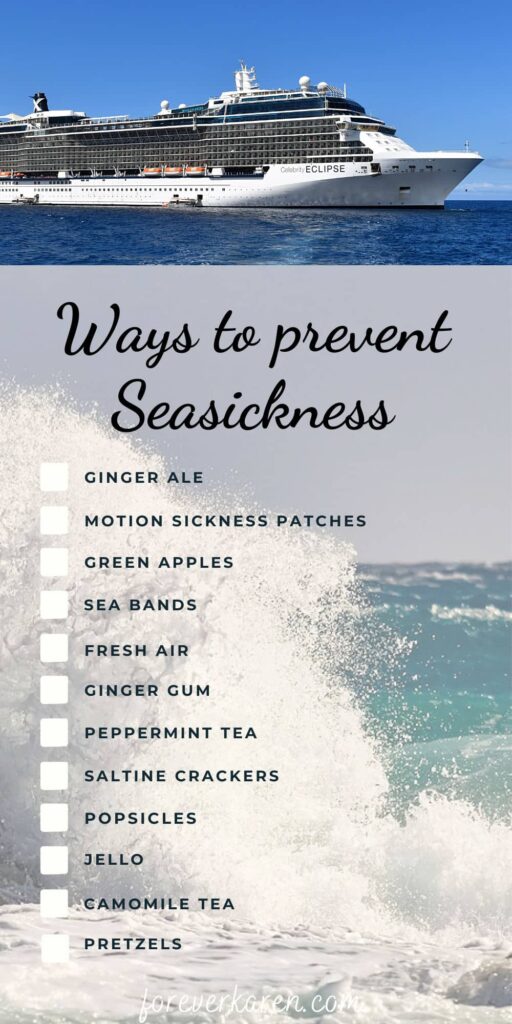Table Of Content
However, exhaustion can exacerbate the effects of motion sickness and make you more susceptible to feeling ill. Be sure to get a good night’s sleep before setting sail, so your body is rested and ready to fight seasickness if it rears its ugly head. There is no reason to avoid a cruise ship if you are prone to feeling seasick! Just being prepared before you board goes a long way in avoiding that nauseous feeling during your first cruise. A day trip on a boat can be a great way to gauge whether you or your travel companions may experience seasickness on an upcoming cruise. We can tell you after taking dozens of cruises, that’s simply not the case.
Prescription-Strength Motion Sickness Medications
Consider this advice some of the essential cruise tips that all passengers should keep in mind before they board. Like many newbies, I was petrified of being unwell on my first ever cruise. I went armed with a whole range of preventative pharmaceuticals, but quickly realised that I could hardly feel the ship moving at all - even across the infamous Bay of Biscay.
Is the Cruise Ship Rocky When You Sail?
You’ll then need to submit receipts to your insurance company to determine what will be reimbursed. The ship’s medical center will likely give you the same advice as you would get at home—drink lots of (nonalcoholic) fluids and rest. If the doctor suspects your symptoms are caused by bacteria rather than a virus, they may prescribe an antibiotic. If medical staff are concerned about your condition, they may advise—and even require—you to seek the advice of specialists on shore, says William Spangler, MD, global medical director with AIG Travel.
How I Finally Discovered A Seasickness Cure That Lets Me Take Cruises - TravelAwaits
How I Finally Discovered A Seasickness Cure That Lets Me Take Cruises.
Posted: Fri, 13 Oct 2023 07:00:00 GMT [source]
How to Avoid Getting Seasick on a Cruise
A cut needing a few stitches can usually be addressed on board, as can minor burns. And for something like a minor fracture or a broken arm, “they might provide a splint and pain medication to get you through the end of the cruise,” says Dr. Spangler. "While Azamara's onboard staff is available to help with any medical issues that arise, the medical facilities are not intended as clinics for guests," a spokesperson says.
I took a Christmas Cruise from Southampton to the Canary Islands, which travelled through the notorious Bay of Biscay. Be sure to join my email list for my best cruise tips and handpicked deals each week. If you don’t, then no harm done – you can just relax and enjoy the holiday in full.
What happens if you get hurt on a cruise ship?

If you forgot your medications and they're not stocked on your ship, you must visit a medical facility ashore. Most cruise lines, including those mentioned above, can perform various tests, as needed, as part of the medical services offered. These include testing for COVID-19, flu, strep or other suspected illnesses. Here's what you need to know before you go, so you can feel confident that you'll have competent and comprehensive medical care if you fall ill while cruising on the high seas.
Smaller ships may be more of a challenge, but here too you’re likely to find stabilizers. A new generation of expedition ships from brands such as Lindblad Expeditions and Aurora Expeditions are designed with an inverted bow, known as an X-Bow, for a smoother ride. You might find it difficult to rest the night before your cruise – who wouldn’t be excited before a trip like this?
A combo of 5-Hydroxytryptophan (5-HTP) and magnesium is another popular treatment to boost serotonin levels and potentially curb seasickness. To be most effective, it’s best to have at least one acupuncture session shortly before your cruise. Many onboard spas now offer the therapy on board to continue your series of treatments. Instead, the cruise ship drops anchor in the harbor, and passengers are ferried to shore on smaller boats called tenders.
Pack disinfectant wipes in your carry-on
Skilled captains also make every effort to avoid rough seas and minimize any uncomfortable sailing conditions. Modern ships are designed with stabilizers on the side of the ship to help counteract the sea’s motion. Seasickness is a form of motion sickness that occurs when there is a discrepancy between the motion of the ship, visual input, and the vestibular system in your inner ear. But since that moment, I’ve always had to plan ahead to make sure I won’t feel seasick.

Even if passengers don’t get seasick, it doesn’t exactly make for a fun vacation. Booking an outside cabin in the middle of the ship -- the natural balance point -- is another option. Probably the easiest thing you can do when you feel seasick is to sleep it off.
For a cruise, add seasickness medication (whether in tablet form like Bonine and Dramamine, or motion sickness patches). Many people find that anti-nausea acupressure wristbands work for them. Cruise Critic highly recommends all passengers bring seasickness medicine with them (like Dramamine or Bonine pills or prescription Scopolamine patches). If you've forgotten to bring medicine with you, you will be able to get the non-prescription tablets onboard.
River Cruise ships barely move at all, and I have never felt seasick on a river cruise. If you are feeling particularly seasick you might want to go to sleep but usually, I don’t. Many older ships have been retrofitted with better stabilisers but if you are worried about seasickness its better to pick a newer ship.
I also listen carefully to the captain’s daily announcements, which usually include a weather forecast for the day ahead. A great option for those who fear getting seasick are the mostly calm inland waters traversed by river ships. Wearing a mask helps ward off spreadable diseases, even the common cold. There are times on a cruise ship when you will be in crowded areas and where social distancing may be difficult. Most modern cruise ships are equipped with advanced stabilization systems that help to minimize the ship’s movement, making your journey smoother and more comfortable.
The easy-to-wear, acupressure-inspired product has a plastic bead that presses against the Nei-Kuan pressure point located on the palm side of the wrist. If you already use acupuncture, you may want to ask your practitioner if he or she thinks it will help to prevent seasickness on your cruise. My mother-in-law, who also suffers from vertigo periodically, uses acupuncture before she goes on a cruise. I’ve been on cruises with her, and have seen how it definitely worked for her.
Cruise lines would generally prefer to keep people spending money inside than walking around in circles on the promenade deck. A lot of the time this works and I don’t need to follow any other of the steps in this guide. When I was on P&O’s Britannia, I was sitting in the Beach House restaurant having just finished a massive meal when Captain Wesley made an announcement to warn guests that the sea might be ‘lumpy’.

No comments:
Post a Comment